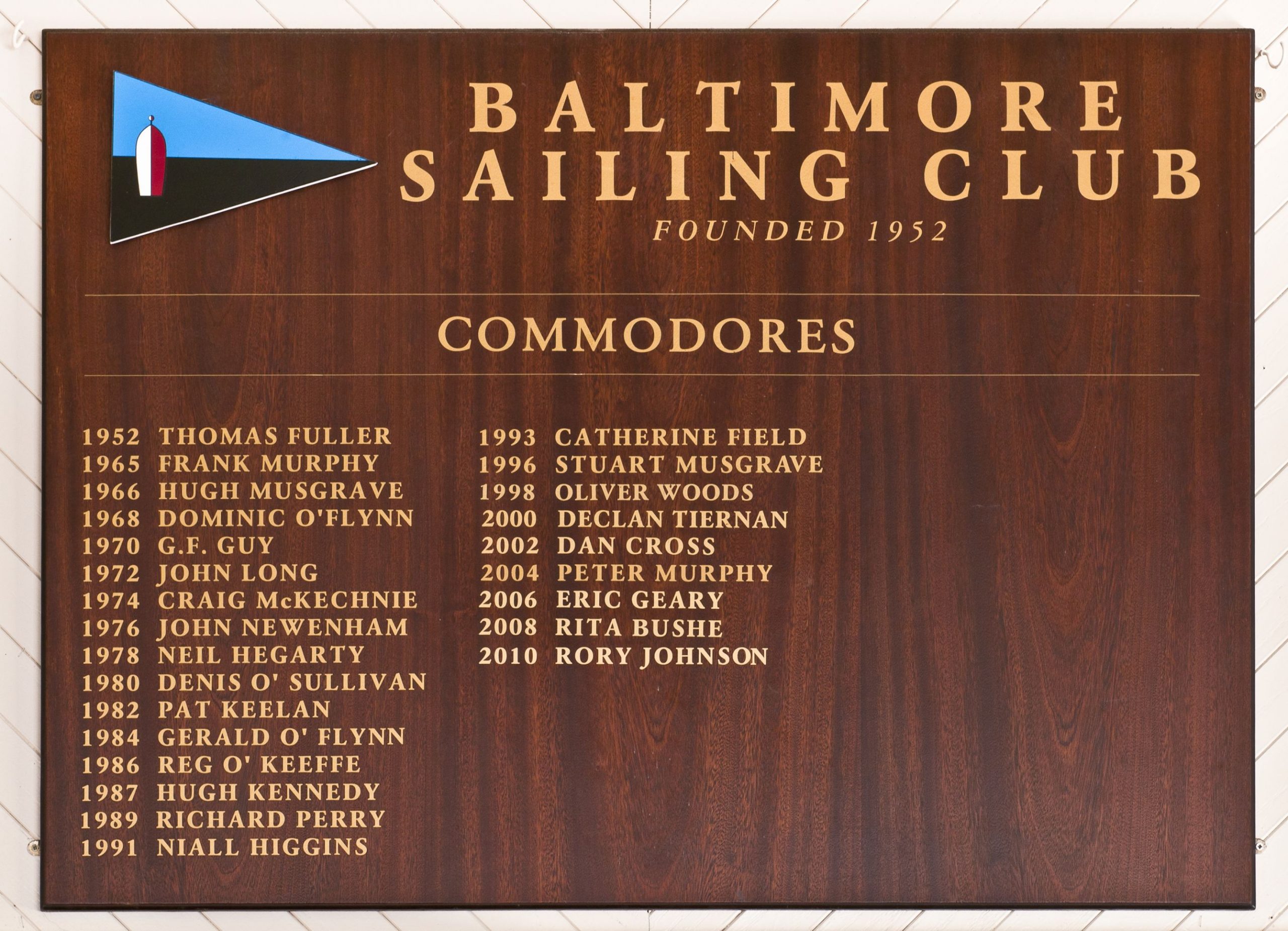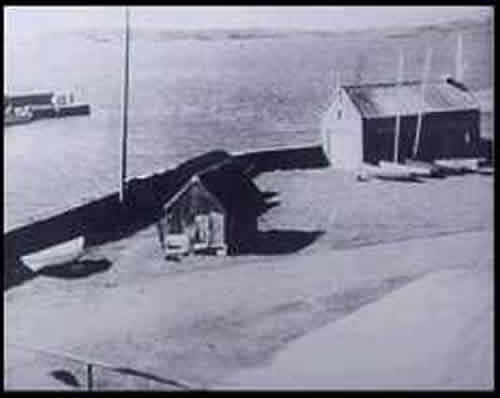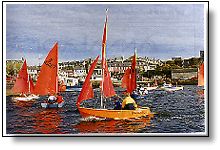The club premises had originally started in Salters Shed in the Harbour and was gradually added to.
The exact year of the foundation of Baltimore Sailing Club is somewhat uncertain! Above the bar, in the Club House, is the formal list of Commodores starting in 1952.

In a letter, dated 3rd August 1976, Frank Murphy, who was the first Secretary of the club, stated that the club was founded in the summer of 1953. The Minutes of a Meeting held at Messrs Salters Baltimore on Saturday 28th July 1956 state that “It was unanimously felt that a Sailing Club should be formed.

Where it all began in 1952
Present were Thomas Fuller, Davis Wolfe, Hugh Musgrave, Ivo Kennedy, Robin Atkins, Alan Marten and Frank Murphy. At that meeting, on the proposal of Mr. Musgrave, seconded by Mr. Murphy, Mr. Thomas Fuller was elected Commodore and on the proposal of Mr. Fuller, seconded by Mr. Musgrave, Mr. Frank Murphy was elected Secretary.
The following Committee was appointed, which would also act as Sailing Committee :-Commodore, Secretary, Robin Atkins and Pip Marten. Baltimore Sailing Club appeared to be the most suitable name but it was decided to withold a decision on this until the next meeting”. So there are three years with a claim to be the start date!
There is no doubt that there was dinghy sailing before 1953, first at Tragumna and then at Baltimore and since the official list of Commodores starts in 1952, this should be the start year. It also enables us to celebrate the 50th Anniversary of the Club in 2002! Those who contest this can organise celebrations in 2003 and 2006!
The most interesting account of the founding of the Baltimore Sailing Club is contained in a letter from Frank Murphy to John Newenham (Commodore 1976) dated 3rd August 1976 from which I quote:-
“You asked me about Tom and the foundation of the Club. The real background is not generally known. Tom was always deeply concerned at the emigration from Baltimore and Skibbereen and spent much time and money here and abroad, and over a long period, in attempts to establish industries to give employment, but without success. I went with him in one of these efforts which took us to Zurich in 1952. Eventually we discussed expanding and developing the indigenous industry of boat building and promoting Baltimore and the islands as a resort for centreboard sailing which would also benefit local tourism.The first step was to get the people who came there “doing it”. Apart from a few motor boats there was only an International 12′, one unclassified 12′ and an old 21/2 ton yacht.
There were increasing numbers of young people both local and summer visitors who could be interested and taught to sail; to start a club was an obvious necessity. I wanted to push on with it but Tom was against doing so until we could be sure of more support. In the early summer of 1953 two more International 12’s arrived; in the week following a third was bought in Crosshaven and, when I called to Tom on the Saturday, he had already heard all and declared we start the club immediately and was passing the news all around for a meeting that night, which was duly held in Salter’s Lounge (now Bushe’s Bar).
He was elected Commodore, and henceforth he and Olive gave it most of their spare time, winter and summer. For years they never missed a weekend on the pier, in fact I only remember one absence in all their years of office when they had to attend the funeral of a relative in England.”
Tom Fuller remained Commodore of the Club until 1966. His successor was Frank Murphy who held the position for a year, followed by Hugh Musgrave for two years. Since then the post has been held 17 Commodores, changing approximately every two years. Above all Baltimore Sailing Club was a family club run on a completely voluntary basis. Today many of the children and grandchildren of the founding families are most active participants. There are a total of approximately 200 members.
There is no doubt that there was dinghy sailing before 1953, first at Tragumna and then at Baltimore and since the official list of Commodores starts in 1952, this should be the start year. It also enables us to celebrate the 50th Anniversary of the Club in 2002! Those who contest this can organise celebrations in 2003 and 2006!
The most interesting account of the founding of the Baltimore Sailing Club is contained in a letter from Frank Murphy to John Newenham (Commodore 1976) dated 3rd August 1976 from which I quote:-
“You asked me about Tom and the foundation of the Club. The real background is not generally known. Tom was always deeply concerned at the emigration from Baltimore and Skibbereen and spent much time and money here and abroad, and over a long period, in attempts to establish industries to give employment, but without success. I went with him in one of these efforts which took us to Zurich in 1952. Eventually we discussed expanding and developing the indigenous industry of boat building and promoting Baltimore and the islands as a resort for centreboard sailing which would also benefit local tourism.The first step was to get the people who came there “doing it”. Apart from a few motor boats there was only an International 12′, one unclassified 12′ and an old 21/2 ton yacht.
There were increasing numbers of young people both local and summer visitors who could be interested and taught to sail; to start a club was an obvious necessity. I wanted to push on with it but Tom was against doing so until we could be sure of more support. In the early summer of 1953 two more International 12’s arrived; in the week following a third was bought in Crosshaven and, when I called to Tom on the Saturday, he had already heard all and declared we start the club immediately and was passing the news all around for a meeting that night, which was duly held in Salter’s Lounge (now Bushe’s Bar).
He was elected Commodore, and henceforth he and Olive gave it most of their spare time, winter and summer. For years they never missed a weekend on the pier, in fact I only remember one absence in all their years of office when they had to attend the funeral of a relative in England.”
Tom Fuller remained Commodore of the Club until 1966. His successor was Frank Murphy who held the position for a year, followed by Hugh Musgrave for two years. Since then the post has been held 17 Commodores, changing approximately every two years. Above all Baltimore Sailing Club was a family club run on a completely voluntary basis. Today many of the children and grandchildren of the founding families are most active participants. There are a total of approximately 200 members.
Extracts from the Archives
Undoubtedly the events which put Baltimore on the Sailing Map of Ireland were the Dinghy Weeks. The first one was held in 1960 and was a huge success. By 1969 the Dinghy Week fleet had risen to 250 boats! In the early days Pip Marten was oustanding in that he would turn his hand to absolutely anything which needed to be repaired or done.
He was a good friend of Tom Fuller and a great help to him. Pip was Treasurer for several years. He now lives in Wisborough Green in Sussex and remembers the early days of the club very well. The dinghy weeks were great events. Reg Fraser (Marys Murphy’s uncle) illuminated the village, castle and church with flood lights. There was a huge amount of work for the Dinghy Weeks. The Ladies Committee had their own bank account from which all the catering was done. They went out for quotes for a whole range of foodstuffs and kitchen equipment well before the event.
| 12′ Internationals | Leprechaun | Charles Cunningham |
| Firefly Class | Coryza | Michael O’Rahilly |
| Solo Class | Soloman | Tom O’Flynn |
| Enterprise Class | Leppin Hi | Dr. Barry Bramwell |
| I.D.R.A 14′ Class | Coulin | Jack O’Reilly |
| Hornet Class | Crew Cut | Maurice Walsh |
| 505 Class | Miss Betty III | J. Clayton Love Jnr. |
| 18′ National Class | Melody | J. Somers Payne |
| Helmsmans Championship | J. Clayton Love |
In the early days starts were in the Cove between the Rocket House next to the Baltimore House Hotel (now the Field’s residence) and a car parked on the grass opposite on Coney Island (now tree covered) in which Olive Fuller sat and beeped the horn. As the fleet grew the start was moved to Fishery Point.
The Treasure Hunt
In the winter of 1956/57 Neil Hegarty, Brian Murphy O’Connor and Dom O’ Flynn built 6 Solo’s and raced them in Baltimore. They had bought the plans from Jack Holt for £36-40 . Hegarty Builders made the wooden parts for £24 , sails from Jeckylls for £20 and parts were bought making a total per boat of £65.
Popular club activities were Quizzes, Treasure hunts, Beetle Drives etc.
A typical Treasure Hunt had the following answers to be supplied:
- A Gabhlog.
- 2 X Examples of “Fucus”.
- 2 X Fried Eggs.
- 3 X Dissimilar Yacht Club Ties.
- The Barber’s…… Song from the Barber of Seville. Fill in blank and bring object.
- Finish this Limerick : “There was a young Lady from Hare …….”
- Waist measurement of “The Maid of Erin”
- A Flea in a Match Box.
- Skibbereen Garda’s Signature, proving Validity of Driving Licence.
- All Males to return wearing Lipstick, Nail Varnish, Hair in Rollers and Long Skirt. Females wearing Clothes Back to Front and two Left Shoes.
The Treasure Hunt started at 5 o’clock on a Thursday night on the slip with sails set. Competitors were given a sealed envelope with the quiz inside with the instruction not to open until afloat. They had to finish at 7 o’clock and marks would be lost if late. There are a dozen answer sheets in the archives all marked with scores for each point.
Three of the Limericks submitted where as follows:
“There was a young lady from Hare,Whose Fireball went up in the air,
She cursed and she swore, called for Admiral Hoare,
Who said “Iv’e had a Pimm’s. I don’t care!”
“There was a young lady from Hare,Who sailed ‘balls with considerable flair,
She capsised one day and could not get away,
For her mast it was stuck right down there.”
“There was a young lady from Hare,Who was possessed of a beautiful pair,
In stormy weather, they clattered together,
And won prizes at Baltimore Fair.”
The latter had the name Musgrave on the submission!! Fireball dinghies were obviously the in-thing then! .
A Sunday Outing With Baltimore Sailing Club
The Club continued to prosper and there was a detailed account in the Cork Examiner on September 14 1961 entitled “A Sunday Outing With Baltimore Sailing Club” with pictures and text as follows:
” After a two hour sail to Castle Island seven miles from Baltimore, the big contingent of visitors settle down to enjoy a picnic. Later they explored the now uninhabited island. On the way back to Baltimore the wind dropped and the yachts were becalmed. All were taken in tow by motor launches and the convoys moved over a glassy sea en route to base at Baltimore where the teenagers of the club had a hot meal prepared.
Members and supporters of the Baltimore Sailing Club were photographed at the pier at Baltimore.”
As the club continued to progres the teaching of young sailors commenced with the old IYA skill stages. Now, under the ISA Junior Sailing Scheme, as many as three, three week courses for levels 1 to 5 are held during the summer with a total of up to 120 young sailors passing each year. Many fully qualified instructors are required to train and supervise this great effort with lots of boats on the water each day.
The Mirror dinghy continues to be the principal training craft. However a one week Optimist Class training has also been held for the last 8 years. The main types of dinghy now racing regularly in the club are Mirrors, Lasers, Toppers, Optimists and Wayfarers.
The importance of Baltimore was emphasized when the Mirror Irish National Championships were held in the summers of 1998 and 1992 with 145 boats in the latter event. The principal organizer was Peter Murphy, the son of founding member Frank. Optimist events have had up to 60 boats participating and a regular Easter event is the Laser Southern Championship.Irish National 18 Championships were held in 1999.
Whilst Cruiser racing in the Harbour had long been a tradition in the club, a major change took place in 1979. That January Neil Hegarty, Joe Kennedy, Richard Perry and Brian Murphy O’Connor went to the London Boat show with their wives and each bought a new 28ft yacht called an Impala.
These yachts were the first cruiser class to arrive in Baltimore. Beagle, Rowena, Crescent Moon and Aeolus began racing each other in 1980 along with J24s and Puppeteers. The class has continued to be supported in Baltimore and this culminated in the Impala European Championship being held here in 1994 with 22 yachts participating in what continues to be described by Impala skippers as their best regatta ever!
The Impalas have since been joined by a class of Ruffians, five of which were built in Skinners yard at Baltimore.


